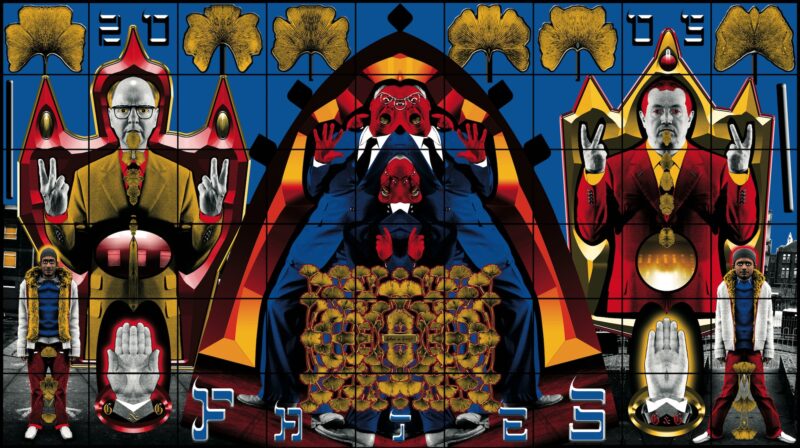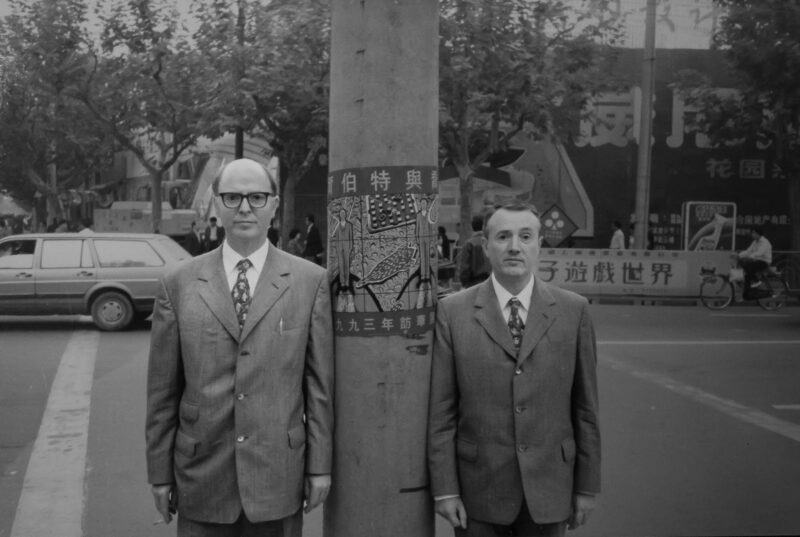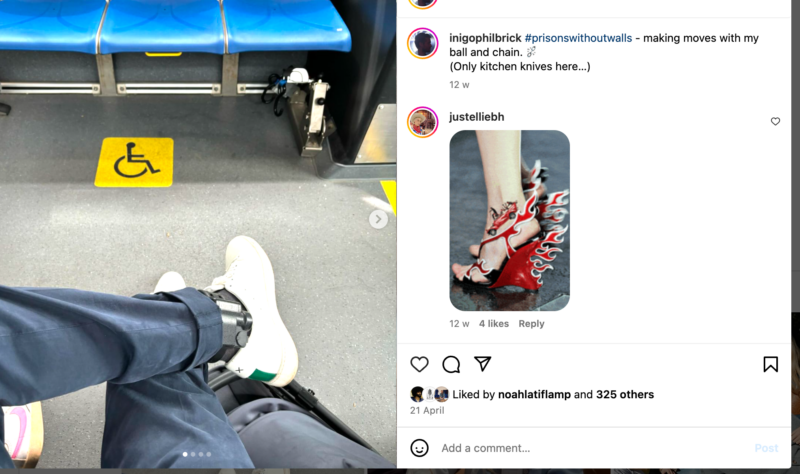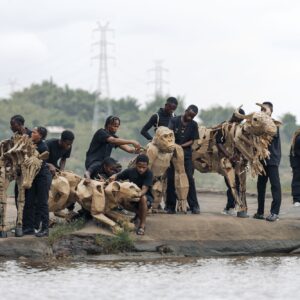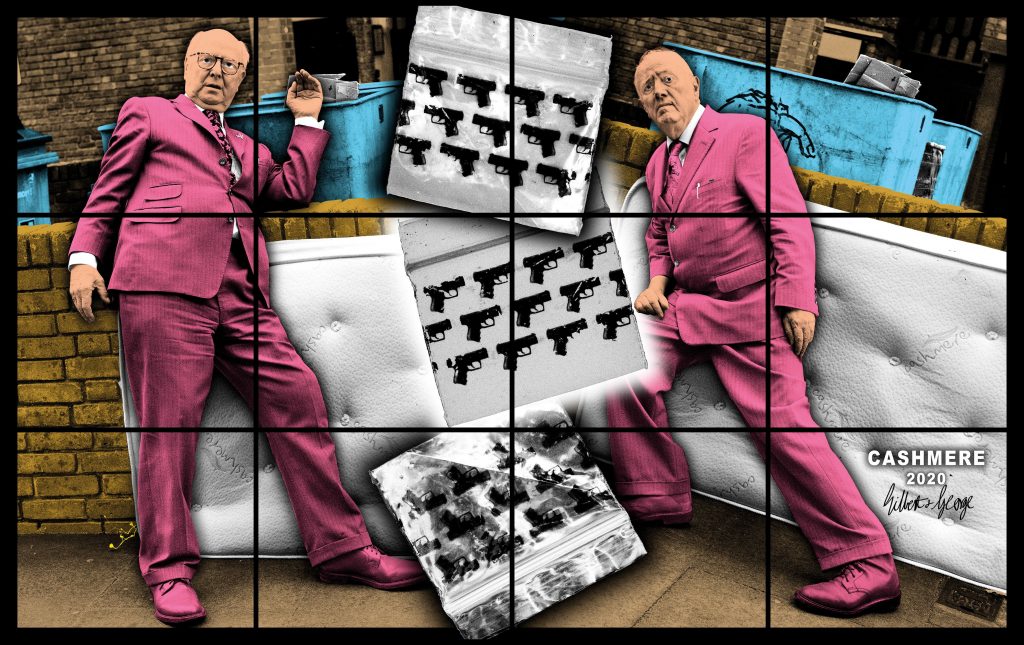
It was on a warm August morning back in 2014, sitting in a curry house in a side street off Brick Lane, when Gilbert told me he had been at Wembley for the 1966 World Cup Final. It was quite noisy in the tiny restaurant – eleven of us were crowded around the table and a great deal of clattering was emanating from the open kitchen – but I am certain that is what he said. We were talking, unusually, about Gilbert’s life before he met George before Gilbert & George was born. He summarised his time at art school in Germany, a childhood in a rural village community in the mountains of northern Italy and his arrival in bustling London in the middle of the Swingin’ 60s. Just as he got to the bit about the World Cup, which must have been a year before he met George at St Martins, he interrupted himself to ask me if he could order for me, to which I heartily agreed because, after all, we do not read menus in the world of Gilbert & George.
We were having lunch, which, in Gilbert & George’s world, occurs at 11 am on the dot. Lunch is always something of an occasion, attracting a procession of guests – temps working in the studio, whoever is staying at Number 10, friends from around Spitalfields – who converge on 12 Fournier Street just before 11 in order to set off on the short walk, in steady, even steps, usually in pairs like a school trip, to the restaurant in Spitalfields Market, the curry house off Brick Lane or the greasy spoon up the Commercial Road. I always sat next to Gilbert, at first by coincidence and then by design when one day he saved a seat for me when it looked as if I might sit elsewhere.
Gilbert always seems to be the quieter of the two; at least, that is their well-rehearsed shtick – George elaborates while Gilbert interjects with pithy remarks – but he is a great storyteller, replete with feeling and light on detail, and that is exactly what attracted me to him. On this particular day, he was telling me how it felt to arrive in London in the 60s, how exciting it was to see the World Cup Final, how refreshing it was to meet George, but very little in the way of facts or biographical nuance. The facts of what actually happened were irrelevant, and he certainly was not going to tell me anything new or interesting (indeed, they never tell anybody anything that is not already reported in Daniel Farson’s biography); but he wanted to impart to me a sense of how it felt, for feelings are the indelible imprints that remain after the facts have become distorted by memory and they are the only things that truly matter in the entire human experience. And that is pretty much all you need to know about Gilbert & George.
Fast forward to 2021 and Gilbert & George are showing their latest series of pictures, the New Normal Pictures, first at White Cube Mason’s Yard and then at Thaddeus Ropac Paris. The images that comprise the New Normal Pictures were all taken before the pandemic, throughout 2019, and the pictures were all finished by the time the pandemic took hold. They follow familiar themes down unusual paths, taking Gilbert & George beyond the immediate vicinity of Fournier Street and Liverpool Street (they once said all their pictures had been made from images shot within a 100-metre radius of their home, which, give or take a smattering of artistic licence, is almost certainly true). This time they have ventured into the residential areas of East London, sometimes even by bus, to explore the varieties of life that subsist in this multicultural, multilingual, melting pot of a city that they have restlessly wandered and probed for more than half a century. In a further break from tradition, Gilbert & George have switched up their process: they usually photograph the locations and then superimpose upon them images of themselves that were shot in the studio, but this time they have photographed themselves on location, in situ among the grit and grease of East End life, death, love, sex, fear and money.
Contrary to what one might think, the phrase ‘new normal’ here has nothing to do with the pandemic and the much-lauded new normal into which we are supposedly jettisoning on the back of a highly infectious deadly respiratory disease. It is just Gilbert & George doing as they do and have done for years, adding the word ‘new’ to the title to indicate that, for them, this series of pictures represents a new strand in their effort to create art for all that expresses the sensation of ordinary life. In this particular series, they are interrogating the normal life of Londoners, as representatives of all humanity, as an existentialist expression of their idea that all human life can be seen on their doorstep.
Listening to Gilbert & George talk about the New Normal Pictures, which consists of the usual intoxicating combination of set-pieces and romanticised, almost poetic, accounts of everyday life, anecdotes from past and present, and exhortations about the nature of art, two things that suddenly open the true nature of Gilbert & George’s art become apparent. On some level, we all grasp the fundamentals and those of us who have spent time with them and even written about them feel we have more than a fleeting grasp, but on a July evening in Thaddeus Ropac Gallery in the big year of 2021, as they talked about their New Normal Pictures, I had an epiphany about Gilbert & George that I neither expected nor thought possible.
First, the sole reason for their success and the absolute kernel of their contentment, pleasure in life and ultimate happiness is just and only their being together; in every story, they tell, such as when George speaks of when they lived in only the two ground floor rooms of 12 Fournier Street and it was so cold at night that they used to go to Whimpy at Liverpool Street to make art in the warm, it is the fact they are together, and not the fact of the art nor the fact of their being two people but one artist, and the feeling that essential togetherness evokes in them that sustains them. Being together – as two humans on earth – is the thing that really gave them life since 1967, for without that the art, the suits and the routines are all meaningless. The core of every story they tell, even if it is subtextual, is always the feeling of that togetherness, which they will, of course, always stop short of saying is romantic, or intimate, or whatever, but we all know the drill by now. Unspoken or not, the bond, the relationship that exists between Gilbert Prousch from the Dolomites, Italy, and George Passmore from Devon, England, is the one thing that is centrally important to them.
And second, that day in the curry house when Gilbert was waxing lyrical about the Dolomites and Wembley, he had no intention of telling me about his life at all. He wanted to convey to me the feelings and sensations a young man had to have in order to end up where he did; he wanted to convey to me the idea that art, and, specifically, the art he has made with George for half a century, is the only way to truly make sense of an existence that otherwise does not make sense. The drama of life and death has an essential futility from an existentialist perspective, and Gilbert & George consider themselves existentialists. And so it is that their pictures are always in the same grid format since 1975, always feature the artists, always shot in the same neighbourhood and always repeat, in phases, the same colour schemes – as artists they are image-makers, but as sculptors, they embody feeling and it is that feeling, the sensation of what it like to exist, that is the one important thing.
